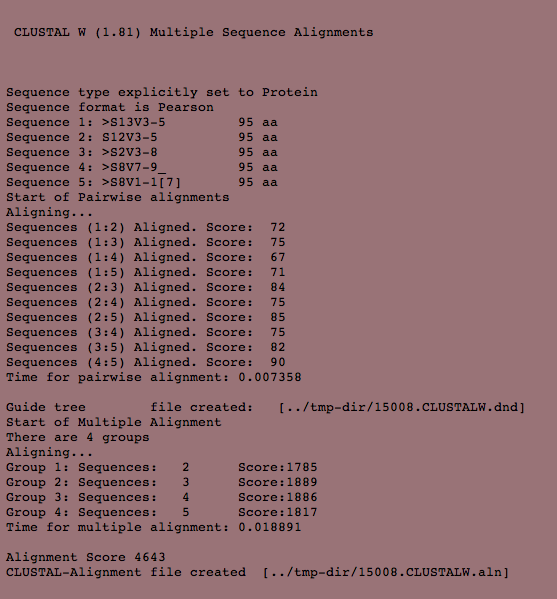Samantha M. Hurndon Week 9
From OpenWetWare
Jump to navigationJump to search
- We will be examining the structures of the nonprogressor types and some of the moderate progressors from the markham study we used during the HIV Evolution project. The specific subjects we will be examining are 2, 8,12,13 as they are subjects who were either classified as moderate progressors or nonprogressors. We will use the Star Biochem tool to analyze the protein structures.
- Presentation: Media:HIVstructureNickiSam.pptx
- Newer version of presentation:Media:HIVstructureNickiSam.ppt
- FINAL Power Point Media:HIVstructureNickiSamFINAL.ppt
- We decided to use subject 2, 8, 12 and 13. 2, 12 and 13 are no-progressors. Therefore, we will be comparing them to subject 8 which is a moderate progressor that developed aids.
- We then went to bedrock site and retrieved the DNA sequences for the subjects
- Randomly select clones for non progressors, however for subject 8 we took visit one and the last visit.
- DNA Sequences
- Subject 8
- Visitone:>S8V1-1GAGGTAGTAATTAGATCCGTCAATCTCACGGACAATGCTAAAGTCATAATAGTACATCTGAATGAATCTGTAGAGATGAATTGTACAAGACCCAACAACAATACAAGAAAAAGTATATCTATAGGACCAGGCAGAGCATTTTATACAACAGGAGAAATAATAGGAGATATAAGACAAGCACATTGTAACCTTAGTAGAGCAAAATGGAATGACACTTTAAAAAATATAGCTATAAAATTAAGAGAACAATTTAAGAATAAAACAATAGTCTTTAATCAATCCTCA
- Visit Seven: >S8V7-9
- GAGGTAGTAATTAGATCCGTCAATCTCACGGACAATGCTAAAGTCATAATAGTACATCTGAATGAATCTGTAGAGATGAATTGTACAAGACCCAACAACAATACAAGAAAAAGGATATCTCTAGGGCCAGGCAGAGTATATTATACAACAGGACAAATAATAGGAGATATAAGAAAAGCATATTGTAACATTAGTAGAGCAAAATGGAATGACGCTTTAAAAAATATAGCTATAAAATTAAGAGAACAATTTAAGAATAAAACAATAGTCTTTAATCAATCCTCA
- Subject 2:
- >S2V3-8
- GAGGTAGTAATTAGATCCGAAAATTTCACGAACAATGCTAAAATCATAATAGTACAGCTGAATAAATCTGTAGAAATTAATTGTACAAGGCCCAACAACAATACAAGAAAAAGTATACATATAGGACCAGGTAGAGCATTTTATACAACAGGAGACATAATAGGAGATATAAGACAAGCACATTGTAACATTAGTAGAGCAGAGTGGAATAACACTTTAAAACAGATAGTTAAAAAATTAAGAGAACACTTTAAGAATAAAACAATAGTCTTTAATCACTCCTCA
- >S2V3-8
- Subject 12:
- >S12V3-5
- GAGGTAGTAATTAGATCCAAGAATTTCACGGATAATGCTAAAATCATAATAGTACAGCTAAATGAGACTGTAGAAATTAATTGTACAAGACCCAACAACAATACAAGAAAAAGTATACCTATAGGACCAGGCAGGGCATTTTATACAACAGGAGAAATAATAGGAGATATAAGACAAGCACATTGTAACCTTAGTAGAGCAAAATGGAATGAAACTTTAAAACAGATAGTTATAAAATTAAAAGAACAATTTAGGAATAAAACAATAGTCTTTAGTCCATCCTCA
- >S12V3-5
- Subject 13:
- >S13V3-5
- GAGATAGTAATTAGATCTGAAAATTTCACAAACAATGCTAAAATCATGATAGTACAGCTGAAGGAATCTGTAGAAATTAATTGTACAAGACCCGGCAACAATACAAGAAGAAGTATAAATATAGGACCAGGGAGAGCATTTTATGCATCAAGAGGAATAATAGGAGATATAAGACAAGCATATTGTAACATCAGTAAAGCAAAATGGGATAACACTTTAGGACAGGTAGCTGCAAAATTAAGAGAACAATTTAGGAATGCTACAATAGTCTTTAATCAATCATCA
- >S13V3-5
- Subject 8
- DNA Sequences
- Now that we retrieved our subjects DNA sequences, we now need to convert the DNA into protein sequences. (I would use NCBI, however the protein sequences are available on bedrock, so we just used that).
- Subject 8:
- Visit 1:
- >S8V1-1(7)EVVIRSVNLTDNAKVIIVHLNESVEMNCTRPNNNTRKSISIGPGRAFYTTGEIIGDIRQAHCNLSRAKWNDTLKNIAIKLREQFKNKTIVFNQSS
- Visit 8:
- >S8V7-9 EVVIRSVNLTDNAKVIIVHLNESVEMNCTRPNNNTRKRISLGPGRVYYTTGQIIGDIRKAYCNISRAKWNDALKNIAIKLREQFKNKTIVFNQSS
- Visit 2: >S2V3-8 EVVIRSENFTNNAKIIIVQLNKSVEINCTRPNNNTRKSIHIGPGRAFYTTGDIIGDIRQAHCNISRAEWNNTLKQIVKKLREHFKNKTIVFNHSS
- Visit 12:
- >S12V3-5 EVVIRSKNFTDNAKIIIVQLNETVEINCTRPNNNTRKSIPIGPGRAFYTTGEIIGDIRQAHCNLSRAKWNETLKQIVIKLKEQFRNKTIVFSPSS
- Visit 13:
- >S13V3-5 EIVIRSENFTNNAKIMIVQLKESVEINCTRPGNNTRRSINIGPGRAFYASRGIIGDIRQAYCNISKAKWDNTLGQVAAKLREQFRNATIVFNQSS
- Visit 1:
- Subject 8:
- We then preformed a multiple sequence alignment on the protein sequences
- I started by going to biology work bench, going to protein tools and adding out protein sequences.
- Chapter 11
- Image
- Perform a multiple sequence alignment on the protein sequences.
- Are there more or fewer differences between the sequences when you look at the DNA sequences versus the protein sequences?
- How do you account for this?
- Which of the procedures from Chapter 6 that you ran on the entire gp120 sequence are applicable to the V3 fragment you are working with now?
- How are they applicable?
- Chapter 11 contains procedures to use for working with protein 3D structures. Find the section on "Predicting the Secondary Structure of a Protein Sequence" and perform this on both the entire gp120 sequence and on the V3 fragment that we are now working with. You will compare the predictions with the actual structures.
- Download the structure files for the papers we read in journal club from the NCBI Structure Database.
- Kwong et al. (1998) structure 1GC1.
- Stanfield et al. (1999) structure 1F58
- Stanfield et al. (1999) structure 2F58
- Stanfield et al. (2003) structure 1NAK
- These files can be opened with the Cn3D software site that is installed on the computers in the lab (this software is free, so you can download it and use it at home, too.) Familiarize yourself with the software features (rendering and coloring) with both the gp120 peptide and ternary complex structures. Alternately, you may choose to use the Star Biochem program to do this portion of your work. Answer the following:
- Find the N-terminus and C-terminus of each (poly)peptide structure.
- Locate all the secondary structure elements. Do these match the predictions you made above?
- Locate the V3 region and figure out which sequences from your alignment are present in the structures and which sequences are absent.
- Once you have oriented yourself, analyze whether the amino acid changes that you see in the multiple sequence alignment would affect the 3D structure and explain why you think this.
- The journal club papers we read are quite old already for a fast-moving field. Using the Web of Science (or PubMed or Structure) databases, find at least one more recent publication that has a structure of gp120 (V3) in it and download the structure file to view. What additional information has been learned from this new paper?
- Your presentation for Week 10 will be formatted similarly to the previous HIV Evolution Project. In this case, you will want to work on creating structure figures that illustrate what result you are trying to show.
- Your presentation will be 15 minutes long (approximately 15 slides, one per minute). Include:
- Title slide
- Outline slide
- Background that led you to ask your research question
- Your question
- How you answered your question, method/results
- Interpretation of your results; answer to your question
- Discussion and interprettion of your results in light of the new paper you found.
- Upload your slides to the OpenWetware wiki by the Week 9 journal assignment deadline. You may make changes to your slides in advance of your presentation, but you will be graded on what you upload by the journal deadline.
▪ Use these Presentation Guidelines when preparing your PowerPoint slides. ▪ Your presentation will also be graded on the following Guide to critiquing talks.



